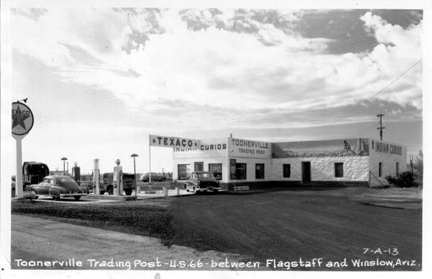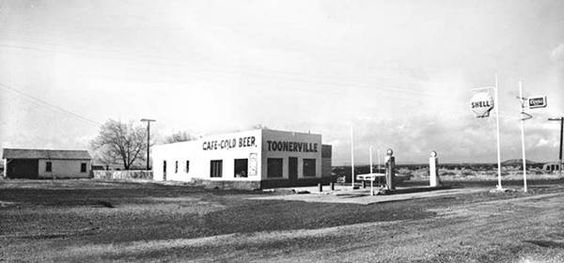
One of the earliest known photos of the Toonerville Trading Post, then selling Texaco fuel and with a bright mural around the top of the building.
Even in its heyday, Route 66 was not the continuous benign bright ribbon that some might imagine. Almost without exception, life was as hard as anywhere else – sometimes harder – and that highway traffic was comprised not only of the military, the commercial traveller and the tourist, but of darker elements. Some places seemed to attract sadness and tragedy more than others, and one such place was Toonerville in Arizona.

Toonerville in the 1960s, now a Shell station and concentrating on the cafe and beer rather than Indian curios.
The Toonerville Trading Post, one of four along a short stretch of Route 66, was built and opened by Earl Tinnin in 1935. He and his wife, Elsie, ran the post and raised two children there, Helen and George Earl. Then, in August 1947, tragedy struck. Apparently, while playing with toy guns, the 14-year-old George picked up a real weapon; the .32 pistol went off and shot him in the left side of his face, killing the boy. In these days of health and safety, the incident raises questions – why was a real gun mixed in with toys? Why didn’t a boy of almost fifteen who had been raised in an isolated area and thus presumably around firearms recognise the difference? It was recorded as an accident, and the Tinnins continue to operate the trading post for a further seven years until, in 1954, Earl sold Toonerville to Merritt Dow ‘Slick’ McAlister and moved to Flagstaff to run the Nor Star and Ben Franklin motels.

The interior of the Toonerville Trading Post [Coconino County Sheriff’s Department]
As the couple approached retirement age they were preparing to wind down. They’d made attempts to sell the trading post with possibly more enthusiasm they had in keeping it going. As Route 66 was realigned and then I-40 opened, the trading post stood apart from the road with just a single GASOLINE sign to promote it. (The trading post did have the only local alcohol licence in the area which brought in local trade.) It may have been this loneliness that, on the afternoon of 30th August 1971, attracted three young people to stop; contemporary newspaper reports first said it was two black couples in two cars, but it appears to have actually been two males and a woman in a small blue sports car and a light coloured sedan.
Within moments of their arrival, Slick McAlister lay dead and his wife desperately injured with a gunshot wound. She had been shot in the back of the head as she cooked hamburgers for the trio, one of whom then shot McAlister in the chest before they ransacked the shop and living quarters, stealing $70 but missing a larger stash of money. However, while they may have assumed the couple were both dead, Pearl later regained consciousness and managed to ring their friends, the Greys, who ran the Twin Arrows trading post a mile down the road. The Greys arrived to find Pearl in a pool of blood, Slick dead and the hamburgers still frying on the stove top.

The Coroner’s Jury examine the murder scene and the open cash register. [Arizona Daily Sun]

Slick McAlister’s gravestone in Pinal Cemetery, Central Heights, Arizona.
Two brothers and a girl were arrested shortly afterwards in Las Vegas, but Mrs McAlister couldn’t identify them and their fingerprints didn’t match those found at the scene. And from that point on the trail went cold. No-one has ever been arrested for the crime and Pearl died in 1999, still not knowing who had slain her husband and almost killed her. In 2014, the Toonerville murder was reopened by the cold case officers of the Coconino County Sheriff’s Department. No new evidence or leads have yet come to light.

Toonerville around a month before Mary Smeal’s death. I haven’t had the heart to photograph it since.
But it wasn’t to be the last tragedy at Toonerville. In recent years, the trading post was converted to a private residence and occupied by Mary Smeal, a leading member of the Historic Route 66 Association of Arizona and chief financial officer for the Hopi Tribe Economic Development Cooperation. Mary had campaigned to save and refurbish the Twin Arrows trading post nearby; many people knew that she had been one of the volunteers involved in preserving and repainting the iconic arrows in 2009, fewer knew that she had paid for all the materials herself. Her next project was to restore the Toonerville property but that all ended a year ago this week. On 16th November 2016, colleagues became concerned that the normally conscientious Mary hadn’t turned up for work. A police welfare check discovered that she had been shot dead by her partner, Jeffrey Jones, who had then turned the gun on himself.
Now Toonerville stands abandoned again, the scene of three deaths wrapped in mystery and about which we will probably never know the full truth.

Toonerville in the 1960s, now a Shell station and concentrating on the cafe and beer rather than Indian curios.

Thanks, that was an interesting story. One of the many ‘Mysteries of the Mother Road’.
LikeLiked by 1 person
Thank you Blue for a touching story of harsh life out in the lonely Arizona back country
LikeLiked by 1 person
I love unsolved crimes! I was going to leave this article to read later, but was drawn in. Superb writing as usual. Thank you for the insights into these wild and lonely places.
LikeLiked by 1 person
Nicely done! A shorter version of the Toonerville story is one of ninety entries in our newest book, Secret Route 66: A Guide to the Weird, Wonderful, and Obscure. I met Mary Smeal in 1999 during the Twin Arrows cleanup. She was a delightful person.
LikeLike
It is indeed a very sad story. Pearl McAlister was my aunt. The fact that these people got away with murder and attempted murder for $70.00 is beyond comprehension. At this point I’m sure this cold case will never be solved.
LikeLike
Hi My name is David Hilderman. My granddad Louis McAlister was Merritt’s cousin. I grew up with the story of the murder and robbery. It was my understanding that pearl was blinded by the bullet that struck her in the back of the head and that She spent the remainder of her days in Las Vegas. I don’t know much more. I’ve passed by there my whole life as we live near Window Rock. Each time I would remember the tragedy and mystery of Toonerville. Thank you for telling the story set in the context of the history of that place.
Dave Hilderman
LikeLiked by 1 person
Pearl was my aunt. While her eyesight was affected by the bullet she was not completely blind. With a magnifying glass she was able to look at pictures, read and write. She lived out her remaining years in Hastings, Nebraska where we visited her often. She worked at the Good Samaritan Society until she retired and continued to live there until her death.
LikeLike